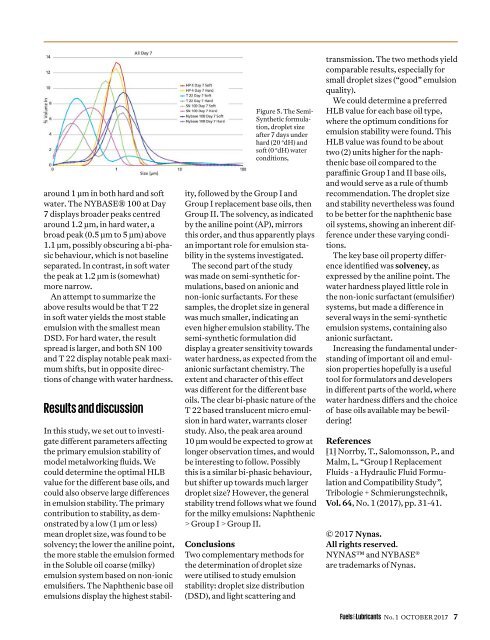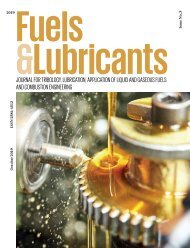Fuels & Lubricants Magazine
Issue 1, October 2017
Issue 1, October 2017
You also want an ePaper? Increase the reach of your titles
YUMPU automatically turns print PDFs into web optimized ePapers that Google loves.
around 1 µm in both hard and soft<br />
water. The NYBASE® 100 at Day<br />
7 displays broader peaks centred<br />
around 1.2 µm, in hard water, a<br />
broad peak (0.5 µm to 5 µm) above<br />
1.1 µm, possibly obscuring a bi-phasic<br />
behaviour, which is not baseline<br />
separated. In contrast, in soft water<br />
the peak at 1.2 µm is (somewhat)<br />
more narrow.<br />
An attempt to summarize the<br />
above results would be that T 22<br />
in soft water yields the most stable<br />
emulsion with the smallest mean<br />
DSD. For hard water, the result<br />
spread is larger, and both SN 100<br />
and T 22 display notable peak maximum<br />
shifts, but in opposite directions<br />
of change with water hardness.<br />
Results and discussion<br />
Figure 5. The Semi-<br />
Synthetic formulation,<br />
droplet size<br />
after 7 days under<br />
hard (20 °dH) and<br />
soft (0 °dH) water<br />
conditions,<br />
In this study, we set out to investigate<br />
different parameters affecting<br />
the primary emulsion stability of<br />
model metalworking fluids. We<br />
could determine the optimal HLB<br />
value for the different base oils, and<br />
could also observe large differences<br />
in emulsion stability. The primary<br />
contribution to stability, as demonstrated<br />
by a low (1 µm or less)<br />
mean droplet size, was found to be<br />
solvency; the lower the aniline point,<br />
the more stable the emulsion formed<br />
in the Soluble oil coarse (milky)<br />
emulsion system based on non-ionic<br />
emulsifiers. The Naphthenic base oil<br />
emulsions display the highest stability,<br />
followed by the Group I and<br />
Group I replacement base oils, then<br />
Group II. The solvency, as indicated<br />
by the aniline point (AP), mirrors<br />
this order, and thus apparently plays<br />
an important role for emulsion stability<br />
in the systems investigated.<br />
The second part of the study<br />
was made on semi-synthetic formulations,<br />
based on anionic and<br />
non-ionic surfactants. For these<br />
samples, the droplet size in general<br />
was much smaller, indicating an<br />
even higher emulsion stability. The<br />
semi-synthetic formulation did<br />
display a greater sensitivity towards<br />
water hardness, as expected from the<br />
anionic surfactant chemistry. The<br />
extent and character of this effect<br />
was different for the different base<br />
oils. The clear bi-phasic nature of the<br />
T 22 based translucent micro emulsion<br />
in hard water, warrants closer<br />
study. Also, the peak area around<br />
10 µm would be expected to grow at<br />
longer observation times, and would<br />
be interesting to follow. Possibly<br />
this is a similar bi-phasic behaviour,<br />
but shifter up towards much larger<br />
droplet size? However, the general<br />
stability trend follows what we found<br />
for the milky emulsions: Naphthenic<br />
> Group I > Group II.<br />
Conclusions<br />
Two complementary methods for<br />
the determination of droplet size<br />
were utilised to study emulsion<br />
stability: droplet size distribution<br />
(DSD), and light scattering and<br />
transmission. The two methods yield<br />
comparable results, especially for<br />
small droplet sizes (“good” emulsion<br />
quality).<br />
We could determine a preferred<br />
HLB value for each base oil type,<br />
where the optimum conditions for<br />
emulsion stability were found. This<br />
HLB value was found to be about<br />
two (2) units higher for the naphthenic<br />
base oil compared to the<br />
paraffinic Group I and II base oils,<br />
and would serve as a rule of thumb<br />
recommendation. The droplet size<br />
and stability nevertheless was found<br />
to be better for the naphthenic base<br />
oil systems, showing an inherent difference<br />
under these varying conditions.<br />
The key base oil property difference<br />
identified was solvency, as<br />
expressed by the aniline point. The<br />
water hardness played little role in<br />
the non-ionic surfactant (emulsifier)<br />
systems, but made a difference in<br />
several ways in the semi-synthetic<br />
emulsion systems, containing also<br />
anionic surfactant.<br />
Increasing the fundamental understanding<br />
of important oil and emulsion<br />
properties hopefully is a useful<br />
tool for formulators and developers<br />
in different parts of the world, where<br />
water hardness differs and the choice<br />
of base oils available may be bewildering!<br />
References<br />
[1] Norrby, T., Salomonsson, P., and<br />
Malm, L. “Group I Replacement<br />
Fluids - a Hydraulic Fluid Formulation<br />
and Compatibility Study”,<br />
Tribologie + Schmierungstechnik,<br />
Vol. 64, No. 1 (2017), pp. 31-41.<br />
© 2017 Nynas.<br />
All rights reserved.<br />
NYNAS and NYBASE ®<br />
are trademarks of Nynas.<br />
<strong>Fuels</strong>&<strong>Lubricants</strong> No. 1 OCTOBER 2017 7







